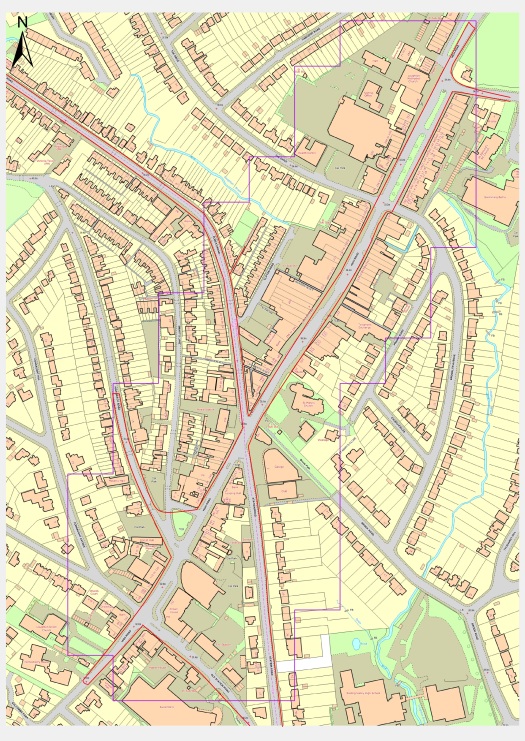As a brand new PhD student on an established project such as Adaptable Suburbs, it is imperative to get to grips with the different aims, collaborators and case study areas. Therefore one of the first things on my agenda was to explore a suburban town centre, one which is one of the four key study sites and was also a relatively unexplored location in the Towards Sustainable Suburban Town Centres project. Therefore on the 4th of January 2012, I journeyed with Dr Laura Vaughan to Loughton. Our aim was to introduce me to the field, but also to notate a map of the town centre with the different businesses present.
to get to grips with the different aims, collaborators and case study areas. Therefore one of the first things on my agenda was to explore a suburban town centre, one which is one of the four key study sites and was also a relatively unexplored location in the Towards Sustainable Suburban Town Centres project. Therefore on the 4th of January 2012, I journeyed with Dr Laura Vaughan to Loughton. Our aim was to introduce me to the field, but also to notate a map of the town centre with the different businesses present.
I spent the journey reading up on the history of Loughton, a brief chapter written by W.R. Powell and available from the British History Online website. Travelling on the Central Line past Mile End means you are suddenly surrounded in the best reading light available, leaf-dappled sunlight. From this chapter of Essex history which Dr Vaughan had kindly printed off for me to peruse, I read a series of interesting facts. I expected that Epping Forest, which lies on the borders of Loughton as well as many other Essex suburban town centres, would play a significant role in the landscape of this settlement. Key industries and transport routes developed due to the forest’s proximity.
Moreover the Epping Forest preservation acts from 1870 onwards also shaped Loughton, as  building stopped moving into the forest westward and instead developed into the East (Powell, 1956). Another key point was the lack of the cheap workman’s fare on public transport in the late 1800s, meaning that the resident population did not attract a high degree of lower-paid workers.
building stopped moving into the forest westward and instead developed into the East (Powell, 1956). Another key point was the lack of the cheap workman’s fare on public transport in the late 1800s, meaning that the resident population did not attract a high degree of lower-paid workers.
When we arrived in Loughton, the first sight was a large food supermarket at a mildly busy intersection between Old Station Road, Station Road and Alderton Hill. It was about 10am on a weekday and though the car park for the supermarket wasn’t full, it was still relatively ‘bustling’ with activity. We made our way down Old Station Road towards High Road, an important thoroughfare which bisects the area within what is currently defined as the Loughton town centre boundary. Within a map of Loughton town centre blown up to A3 size (which featured the aforementioned boundary lines) I notated what businesses were contained in each building, unless it was a residential or other classification of property.
Issues about categorization and overlapping locations were resolved through discussion with Dr Vaughan. These issues refer to terminology of certain business types and how to notate a business which was on the floor above or below another separate business. To clarify my notes I also used a digital SLR camera, which I hoped would help me later when I used this collected data to geolocate Loughton’s businesses into a GIS data set. The images within this blog entry are some of those I took, the rest are available on the Adaptable Suburbs’ Flickr photostream.
The route we followed is depicted on the map below.
 After exploring the Northern perimeter of Station Road, Dr Vaughan and I went to the library to examine their local history section. This will undoubtedly be a vital resource for my future research, especially as it has a wealth of pictorial records which illustrate the early development of Loughton. As a student with a fascination in visual ethnography, photographic historical records are of particular interest to me.One photograph stood out in specifically, which depicted the town centre in the 1800s. I then took a photograph of that same point for comparison (see below).
After exploring the Northern perimeter of Station Road, Dr Vaughan and I went to the library to examine their local history section. This will undoubtedly be a vital resource for my future research, especially as it has a wealth of pictorial records which illustrate the early development of Loughton. As a student with a fascination in visual ethnography, photographic historical records are of particular interest to me.One photograph stood out in specifically, which depicted the town centre in the 1800s. I then took a photograph of that same point for comparison (see below).
At this point Dr Laura Vaughan departed and I finished the business mapping alone. This was a great way to explore the site, get to grips with the project’s methodology as well as cultivate my own routes of enquiry. For example, I couldn’t help but notice the location, architecture and multiple functions of the local churches. I encountered five in my short visit, three of which were along the High Road and within few minutes walking distance of each other. I am sure that this is not unique to Loughton, however the diversifying functions each of these churches seemed to be partaking in may be a matter for further study. 
 As a local café, careers advice centre, leisure centre annex or school, the local churches were facilitating important community participation and development in ways I hadn’t previously considered.
As a local café, careers advice centre, leisure centre annex or school, the local churches were facilitating important community participation and development in ways I hadn’t previously considered.
Whether or not an investigation into such activity will be beneficial is still uncertain. However it highlights the importance of becoming familiar with the field as soon as possible when beginning research. It can produce new insights and possible study avenues, in addition to retrieval of the actual data you set out to find.
I will be paying similar visits to other Greater London suburban town centres, especially three key sites within the focus of the Adaptable Suburbs project: High Barnet; South Norwood and Surbiton. Already in the process of inputting the data I gathered from the Loughton field trip, l hope that it won’t be too long before I can be out in the field again.


